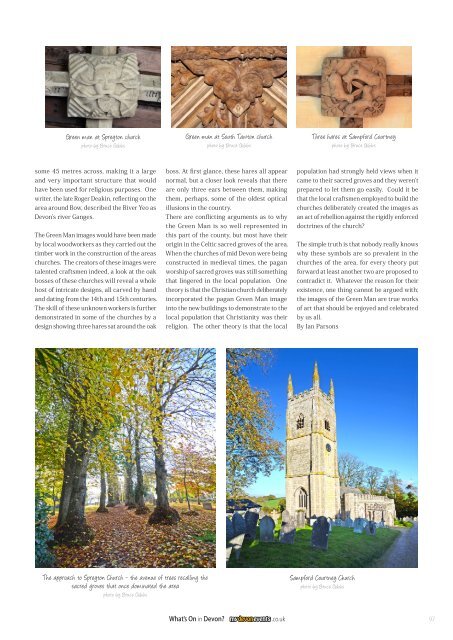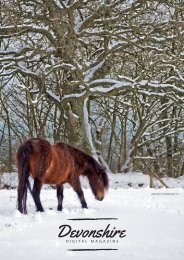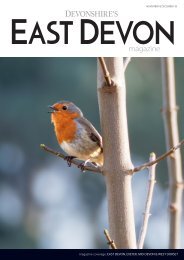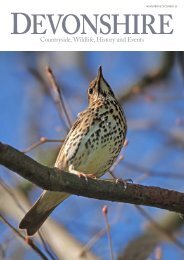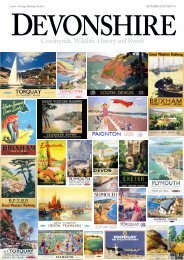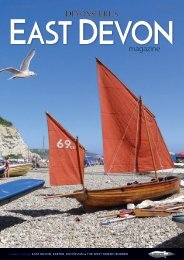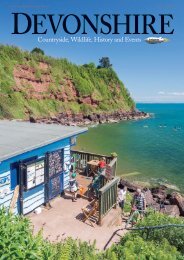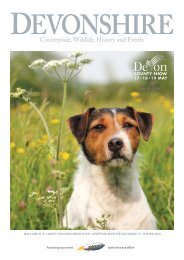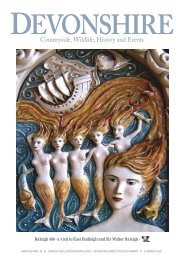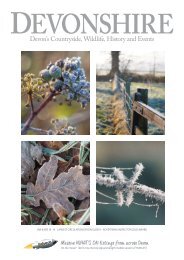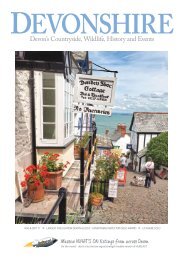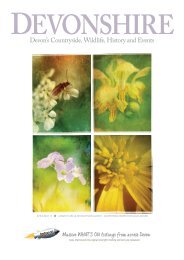Devonshire Feb and Mar 16
You also want an ePaper? Increase the reach of your titles
YUMPU automatically turns print PDFs into web optimized ePapers that Google loves.
Green man at Spreyton church<br />
photo by Bruce Gibbs<br />
Green man at South Tawton church<br />
photo by Bruce Gibbs<br />
Three hares at Sampford Courtney<br />
photo by Bruce Gibbs<br />
some 45 metres across, making it a large<br />
<strong>and</strong> very important structure that would<br />
have been used for religious purposes. One<br />
writer, the late Roger Deakin, reflecting on the<br />
area around Bow, described the River Yeo as<br />
Devon’s river Ganges.<br />
The Green Man images would have been made<br />
by local woodworkers as they carried out the<br />
timber work in the construction of the areas<br />
churches. The creators of these images were<br />
talented craftsmen indeed, a look at the oak<br />
bosses of these churches will reveal a whole<br />
host of intricate designs, all carved by h<strong>and</strong><br />
<strong>and</strong> dating from the 14th <strong>and</strong> 15th centuries.<br />
The skill of these unknown workers is further<br />
demonstrated in some of the churches by a<br />
design showing three hares sat around the oak<br />
boss. At first glance, these hares all appear<br />
normal, but a closer look reveals that there<br />
are only three ears between them, making<br />
them, perhaps, some of the oldest optical<br />
illusions in the country.<br />
There are conflicting arguments as to why<br />
the Green Man is so well represented in<br />
this part of the county, but most have their<br />
origin in the Celtic sacred groves of the area.<br />
When the churches of mid Devon were being<br />
constructed in medieval times, the pagan<br />
worship of sacred groves was still something<br />
that lingered in the local population. One<br />
theory is that the Christian church deliberately<br />
incorporated the pagan Green Man image<br />
into the new buildings to demonstrate to the<br />
local population that Christianity was their<br />
religion. The other theory is that the local<br />
population had strongly held views when it<br />
came to their sacred groves <strong>and</strong> they weren’t<br />
prepared to let them go easily. Could it be<br />
that the local craftsmen employed to build the<br />
churches deliberately created the images as<br />
an act of rebellion against the rigidly enforced<br />
doctrines of the church?<br />
The simple truth is that nobody really knows<br />
why these symbols are so prevalent in the<br />
churches of the area, for every theory put<br />
forward at least another two are proposed to<br />
contradict it. Whatever the reason for their<br />
existence, one thing cannot be argued with;<br />
the images of the Green Man are true works<br />
of art that should be enjoyed <strong>and</strong> celebrated<br />
by us all.<br />
By Ian Parsons<br />
The approach to Spreyton Church - the avenue of trees recalling the<br />
sacred groves that once dominated the area<br />
photo by Bruce Gibbs<br />
Sampford Courtney Church<br />
photo by Bruce Gibbs<br />
mydevonevents 97


